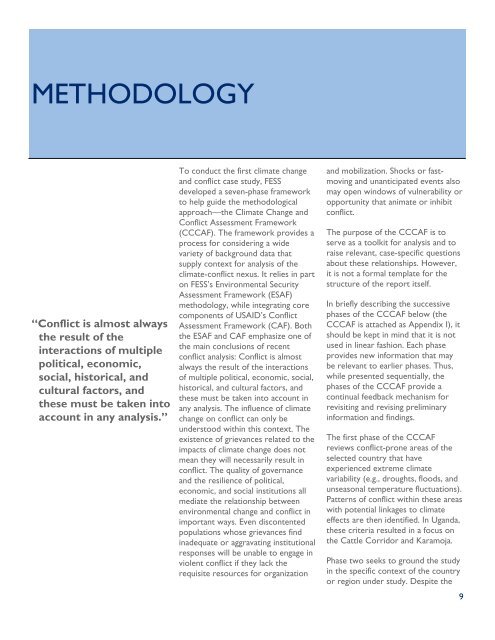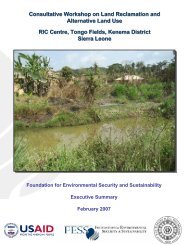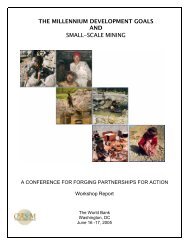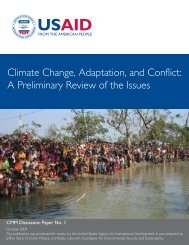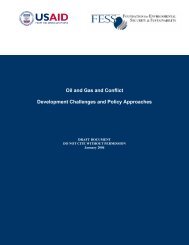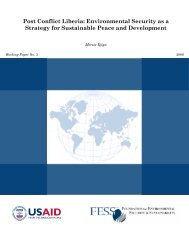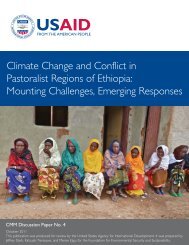Climate Change and Conflict in Uganda: The Cattle Corridor - FESS ...
Climate Change and Conflict in Uganda: The Cattle Corridor - FESS ...
Climate Change and Conflict in Uganda: The Cattle Corridor - FESS ...
Create successful ePaper yourself
Turn your PDF publications into a flip-book with our unique Google optimized e-Paper software.
METHODOLOGY<br />
“<strong>Conflict</strong> is almost always<br />
the result of the<br />
<strong>in</strong>teractions of multiple<br />
political, economic,<br />
social, historical, <strong>and</strong><br />
cultural factors, <strong>and</strong><br />
these must be taken <strong>in</strong>to<br />
account <strong>in</strong> any analysis.”<br />
To conduct the first climate change<br />
<strong>and</strong> conflict case study, <strong>FESS</strong><br />
developed a seven-phase framework<br />
to help guide the methodological<br />
approach—the <strong>Climate</strong> <strong>Change</strong> <strong>and</strong><br />
<strong>Conflict</strong> Assessment Framework<br />
(CCCAF). <strong>The</strong> framework provides a<br />
process for consider<strong>in</strong>g a wide<br />
variety of background data that<br />
supply context for analysis of the<br />
climate-conflict nexus. It relies <strong>in</strong> part<br />
on <strong>FESS</strong>’s Environmental Security<br />
Assessment Framework (ESAF)<br />
methodology, while <strong>in</strong>tegrat<strong>in</strong>g core<br />
components of USAID’s <strong>Conflict</strong><br />
Assessment Framework (CAF). Both<br />
the ESAF <strong>and</strong> CAF emphasize one of<br />
the ma<strong>in</strong> conclusions of recent<br />
conflict analysis: <strong>Conflict</strong> is almost<br />
always the result of the <strong>in</strong>teractions<br />
of multiple political, economic, social,<br />
historical, <strong>and</strong> cultural factors, <strong>and</strong><br />
these must be taken <strong>in</strong>to account <strong>in</strong><br />
any analysis. <strong>The</strong> <strong>in</strong>fluence of climate<br />
change on conflict can only be<br />
understood with<strong>in</strong> this context. <strong>The</strong><br />
existence of grievances related to the<br />
impacts of climate change does not<br />
mean they will necessarily result <strong>in</strong><br />
conflict. <strong>The</strong> quality of governance<br />
<strong>and</strong> the resilience of political,<br />
economic, <strong>and</strong> social <strong>in</strong>stitutions all<br />
mediate the relationship between<br />
environmental change <strong>and</strong> conflict <strong>in</strong><br />
important ways. Even discontented<br />
populations whose grievances f<strong>in</strong>d<br />
<strong>in</strong>adequate or aggravat<strong>in</strong>g <strong>in</strong>stitutional<br />
responses will be unable to engage <strong>in</strong><br />
violent conflict if they lack the<br />
requisite resources for organization<br />
<strong>and</strong> mobilization. Shocks or fastmov<strong>in</strong>g<br />
<strong>and</strong> unanticipated events also<br />
may open w<strong>in</strong>dows of vulnerability or<br />
opportunity that animate or <strong>in</strong>hibit<br />
conflict.<br />
<strong>The</strong> purpose of the CCCAF is to<br />
serve as a toolkit for analysis <strong>and</strong> to<br />
raise relevant, case-specific questions<br />
about these relationships. However,<br />
it is not a formal template for the<br />
structure of the report itself.<br />
In briefly describ<strong>in</strong>g the successive<br />
phases of the CCCAF below (the<br />
CCCAF is attached as Appendix I), it<br />
should be kept <strong>in</strong> m<strong>in</strong>d that it is not<br />
used <strong>in</strong> l<strong>in</strong>ear fashion. Each phase<br />
provides new <strong>in</strong>formation that may<br />
be relevant to earlier phases. Thus,<br />
while presented sequentially, the<br />
phases of the CCCAF provide a<br />
cont<strong>in</strong>ual feedback mechanism for<br />
revisit<strong>in</strong>g <strong>and</strong> revis<strong>in</strong>g prelim<strong>in</strong>ary<br />
<strong>in</strong>formation <strong>and</strong> f<strong>in</strong>d<strong>in</strong>gs.<br />
<strong>The</strong> first phase of the CCCAF<br />
reviews conflict-prone areas of the<br />
selected country that have<br />
experienced extreme climate<br />
variability (e.g., droughts, floods, <strong>and</strong><br />
unseasonal temperature fluctuations).<br />
Patterns of conflict with<strong>in</strong> these areas<br />
with potential l<strong>in</strong>kages to climate<br />
effects are then identified. In Ug<strong>and</strong>a,<br />
these criteria resulted <strong>in</strong> a focus on<br />
the <strong>Cattle</strong> <strong>Corridor</strong> <strong>and</strong> Karamoja.<br />
Phase two seeks to ground the study<br />
<strong>in</strong> the specific context of the country<br />
or region under study. Despite the<br />
9


